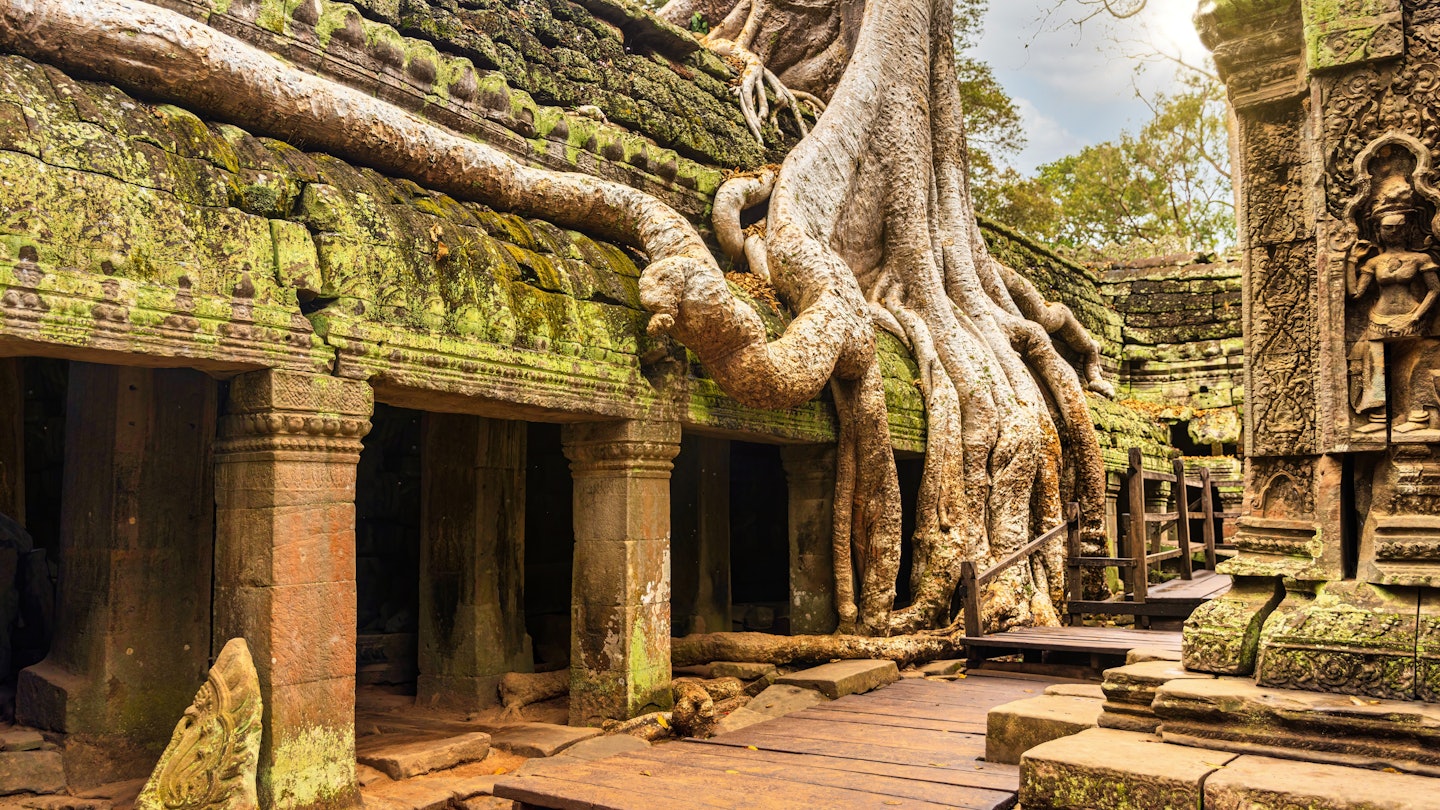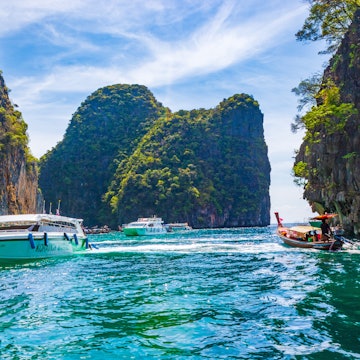

Wander through the timeworn gateways of Angkor Wat, one of the highlights of Asia. Framalicious/Shutterstock
Packed with some of Southeast Asia's best experiences, from ancient temples to flawless beaches and wonderful wildlife, it's worth taking a few weeks to explore Cambodia.
Phnom Penh, the once-ravaged but now resurgent capital, is the place to check the pulse of contemporary life in Cambodia. However, Siem Reap is starting to give the capital a run for its money with its sophisticated restaurants, lively bars and chic boutiques. And it's an excellent base from which to explore UNESCO World Heritage-listed Angkor, home to some of the most spectacular temples on earth.
Down on the South Coast are several up-and-coming beach resorts and a smattering of tropical islands that are really beginning to take off. Northwestern Cambodia is home to the French-colonial city of Battambang, offering a more traditional slice of Cambodian life and several remote jungle temples, while the country’s wild east is where elephants roam, waterfalls thunder and freshwater dolphins frolic.
All in all, it's quite a package. Start your adventure now with our round-up of the best places to visit in Cambodia.
1. The temples of Angkor
Best for spectacular spirituality
One of the world’s most iconic destinations, the temples of Angkor regularly take the number one spot on lists of the world’s top sights. The most iconic structures here are Angkor Wat, the world’s largest religious building, and the Bayon, one of the world’s most unique temples, with its enigmatic collection of carved stone faces. Then there's Ta Prohm, where wild nature has run riot over ancient carved masonry.
The ancient Khmers packed the equivalent of all Europe's cathedrals into an area the size of Los Angeles, so it pays to take time to explore. There are plenty of outlying temple sites that see smaller crowds, including exquisitely carved Banteay Srei, the overgrown ruins of Beng Mealea and the Mayan-style pyramid temple of Prasat Thom at Koh Ker.
Planning tip: Dress modestly out of respect for the site, and especially while visiting the highest level of Angkor Wat. You won't be permitted to enter without covering your upper arms and wearing shorts that reach at least your knees.

2. Cambodia's Southern Islands
Best for beaches
While the sand-sprinkled Cambodian coast may not be as famous as the beaches of Thailand or Indonesia, it still offers a full tropical hideaway experience, only without the crazy crowds. Neighboring Koh Rong and Koh Rong Sanloem are the most popular islands, fringed by azure waters and abundant powder-white sand.
There are many more islands along the coast, including the largely undiscovered Koh Sdach Archipelago and the large, almost undeveloped Koh Kong. Don't overlook the smaller islands close to overbearing Sihanoukville, like Koh Russey with its upscale resorts and Koh Ta Khiev with its low-key backpacker bungalows.
3. Kampot and Kep
Best for countryside scenery
These twin provinces down south offer a perfect combination of travel comforts and authentic character for those seeking a more rounded experience than the stop-and-flop vibe on the islands. Charming Kampot town offers a wide range of backpacker hostels, riverside resorts and boutique hotels where you can base yourself while you take in the French architectural legacy, explore the pretty river by paddleboard or kayak, or venture into the bucolic countryside on two wheels.
Beachside boutique charmer Kep has its famous Crab Market, hiking in Kep National Park and nearby Koh Tonsay (Rabbit Island), a great spot to escape the hubbub. Rural adventures include the winding ascent to the atmospheric Bokor Hill Station, hidden cave pagodas from the 7th century, and visits to rustic pepper farms.
Planning tip: Take time to cruise through the salt flats at sunset as workers use a traditional yoke and baskets to harvest the region's white gold.

4. Phnom Penh
Best for fine dining and nightlife
The Cambodian capital is a chaotic yet charming city that has stepped out of the shadows of its war-torn past to embrace a brighter future. Boasting one of the most beguiling riverfronts in Southeast Asia, Phnom Penh is emerging as a sophisticated modern capital thanks to its impressive collection of boutique hotels, epicurean eateries and boho bars.
Urban explorers can feast all day and party all night, or experience the inspiring National Museum and the harrowing Tuol Sleng prison, showcasing the best and worst of Cambodian history. Once known as the "Pearl of Asia," Phnom Penh is regaining its shine.
Planning tip: Dive into the city's quirky nightlife with a visit to Bassac Lane, a small alleyway packed with eclectic closet-sized bars serving delicious cocktails.
5. The Cardamom Mountains
Best for motorcycle adventures
The vast 20,746 sq km Cardamom Rainforest Landscape protected area includes one of the last great wilderness regions of Southeast Asia – the remote Cardamom Mountains. An area of breathtaking beauty and astonishing biodiversity, this green corridor includes many of Cambodia’s most outstanding natural sites.
If you can, explore by motorcycle to immerse yourself in the landscape. Highlights include the isolated Stung Areng Valley, the rolling grasslands and dramatic drop-offs of Khnong Phsar, award-winning ecolodges in Botum Sakor National Park and the Tatai Wildlife Sanctuary with its iconic waterfall, myriad eco-adventures and fairytale accommodation. If you want to take a ride on the wild side, the Cardamom Mountains are the place to do it.
Planning tip: Hang onto your motorcycle for a little longer and explore Cambodia on one of our five favorite road trips on two wheels.

6. Siem Reap
Best for a taste of local life
Siem Reap’s only reason for existence may be as the gateway to the temples of Angkor, but this charming town has emerged as a world-class destination in its own right, thanks to a superb selection of restaurants, cafes and bars, not to mention energetic markets, cool boutiques and edgy galleries.
Beyond the town center lie otherworldly floating villages on the Tonlé Sap lake, adventure activities such as quad biking and ziplining, and cultural pursuits such as cooking classes and martial arts courses.
For a different experience, head to nearby traditional villages, where it's possible to experience local life in simple, welcoming homestays. Siem Reap has renovated roads, riverside gardens and cycle lanes throughout the city.
Planning tip: Take a city tour with a difference and zip through the streets of Siem Reap on a Vespa.
7. Mondulkiri
Best for wildlife-spotting
In the northeast of the country, the endless rice fields and sugar palms that characterize the landscape in most of Cambodia give way to the wild rolling hills of Mondulkiri, home to the Indigenous Bunong people.
Wildlife is a big draw here, with opportunities to "walk with the herd" at Elephant Valley Project (a great alternative to harmful elephant-riding) or spot douc langurs or gibbons on a trek through the Keo Seima Wildlife Sanctuary. Add thunderous waterfalls and a jungle zipline to the mix, and you have the perfect ingredients for an ecotourism adventure.

8. Battambang
Best for contrasting historic architecture
Winding along the banks of the Sangker River, Battambang is the traditional face of urban Cambodia and one of the country’s best-preserved colonial-era towns. Streets of shophouses host everything from Fairtrade cafes to art galleries. Beyond the town in the countryside is a cluster of ancient temples, which, while not in the same league as the temples of Angkor, are still beautiful and less crowded.
Battambang is also the home of the inspiring Phare Ponleu Selpak, a renowned arts NGO that trains performing artists and hosts inspirational performance art shows that combine circus skills with theater and storytelling. Battambang is a world away from the crush of Phnom Penh and the crowds of Angkor, and definitely worth a deviation from the tourist trail.
9. Preah Vihear Temple
Best for ruins with a view
The mother of all mountain temples, Prasat Preah Vihear, stands majestically atop the Dangkrek Mountains, the forest-cloaked ridge that forms a once-contested border between Cambodia and Thailand. The foundation stones of the temple stretch right to the edge of a cliff that falls precipitously away to the plains below, and the views across northern Cambodia are absolutely breathtaking.
Constructed more than 300 years ago, the temple is a three-dimensional representation of Mt Meru, the center of the universe in Hindu mythology. It offers some fascinating insights into the evolution of carving and sculpture during the Angkorian period. It’s all about location, though, and it doesn’t get better than this – remote, hard to reach, but well worth the effort.
Planning tip: Bring your passport – you'll need to show it when purchasing an entry ticket.

10. Kratie
Best for Mekong River adventures
The jumping-off point for trips to spot rare freshwater Irrawaddy dolphins on the Mekong River, Kratie is a busy junction on the overland route between Phnom Penh and northeastern Cambodia or southern Laos. Dolphins aside, the town has a certain decaying colonial charm and boasts some of the country’s best Mekong sunsets.
Nearby Koh Trong island is a relaxing place to experience authentic Khmer hospitality at a local homestay or explore by rented bike. North of Kratie lies the Mekong Discovery Trail, with a host of adventures and experiences themed around the mother river, including community-based homestays, bicycle rides and boat trips.














